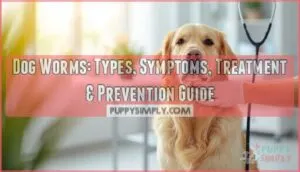This site is supported by our readers. We may earn a commission, at no cost to you, if you purchase through links.

Your dog’s body can host several unwelcome residents that steal nutrients and damage organs from the inside. Dog worms are internal parasites that range from microscopic organisms to tapeworms stretching over two feet long. These parasites establish themselves in your pet’s digestive system or even the heart and lungs.
They reproduce rapidly by laying thousands of eggs that spread through feces and contaminate soil where other dogs play. The health consequences extend beyond your dog. Some worm species can transfer to humans through accidental contact with contaminated surfaces.
Regular prevention stops these parasites before they cause malnutrition, anemia, or organ damage in your pet.
Table Of Contents
- Key Takeaways
- What Are Dog Worms?
- Types of Worms in Dogs
- How Dogs Get Worms
- Symptoms of Worms in Dogs
- Diagnosing Worms in Dogs
- Treating Worms in Dogs
- Preventing Worms in Dogs
- Risks of Worms to Human Health
- Worm Prevalence and Risk Factors
- When to Seek Veterinary Help
- Frequently Asked Questions (FAQs)
- How can I tell if my dog has worms if they are not showing any symptoms?
- Are there any breeds of dogs that are more susceptible to worm infections than others?
- Can worms cause permanent damage to my dog?
- Are over-the-counter dewormers as effective as prescription?
- How long after treatment will worms disappear?
- Can my dog get reinfected immediately after treatment?
- Do indoor dogs still need regular deworming?
- Conclusion
Key Takeaways
- Dog worms are internal parasites that inhabit your pet’s digestive system or cardiovascular system, with infection rates reaching 58% in some populations and posing zoonotic risks to humans, especially children.
- The five main types include roundworms (most common, transmitted before birth), hookworms (cause severe anemia), tapeworms (transmitted through fleas), whipworms (survive years in soil), and heartworms (invade heart and lungs through mosquito bites).
- Diagnosis requires fecal examination by a veterinarian since many infected dogs show no symptoms, and treatment involves specific deworming medications like fenbendazole or praziquantel with follow-up testing after 2-4 weeks.
- Prevention through monthly medication, regular deworming schedules (every 2 weeks for puppies, every 3-6 months for adults), immediate waste disposal, and flea control stops infections before they cause malnutrition, organ damage, or transmission to family members.
What Are Dog Worms?
Dog worms are parasites that live inside your dog’s digestive system and can cause serious health problems if left untreated. These unwelcome guests set up camp in different parts of the gastrointestinal tract and multiply by laying eggs.
Understanding what these parasites are and where they live helps you recognize why regular prevention and treatment matter for your dog’s health.
Definition of Dog Worms
Dog worms are internal parasites that live inside your dog’s body. These organisms fall under the helminth classification and generally inhabit the gastrointestinal tract or cardiovascular system.
Types of worms in dogs include roundworms, hookworms, tapeworms, whipworms, and heartworms. These intestinal parasites survive by feeding on your dog’s blood, nutrients, or tissue. This creates nutritional deficiency and poses zoonotic risks to humans. Some species cause cardiovascular impact that can threaten your dog’s life.
Regular deworming is essential, especially for dogs with a high risk of infection.
Where Worms Live in Dogs
Most worms in your dog settle in the gastrointestinal tract, including the small intestine, large intestine, stomach, and esophagus. Each species has preferred intestinal habitats where they compete for nutrients and multiply.
- Roundworms inhabit the small intestine but their larvae can migrate through lungs before returning
- Hookworms attach to small intestine walls and feed on blood
- Tapeworms anchor themselves in the small intestine using teeth-like structures
- Whipworms reside in the large intestine, particularly the cecum and colon
Annual vet visits can help with intestinal parasite detection.
Why Worms Are a Health Concern
These parasites threaten far more than digestion. Parasite infection can cause gastrointestinal illness, anemia from blood loss, and even intestinal blockage in severe cases. Heavy burdens stunt puppy growth by stealing nutrients.
Infection prevalence reaches 58% in some populations. Zoonotic diseases in dogs create human health risks, especially for children.
Systemic impact extends beyond the gut, and welfare implications affect your dog’s quality of life.
Types of Worms in Dogs
Dogs can pick up several different types of worms that affect their health in distinct ways. Each worm species has unique characteristics and presents different risks to your dog.
Understanding these common parasites helps you recognize what you’re dealing with and why proper treatment matters.
Roundworms
Among intestinal parasites in dogs, roundworms rank as the most widespread threat to your pet. These parasites measure 8-10 cm long and pose serious zoonotic potential to children. Transplacental transmission means nearly all puppies carry roundworms at birth.
Key concerns include:
- Larval migration through liver and lungs causing tissue damage
- Environmental persistence with eggs surviving years in soil
- Detection through fecal buoyancy testing
- Daily egg production reaching 85,000 per adult female worm
Hookworms
Blood-feeding parasites in the canine intestine, hookworms measure just 0.5-2 cm but cause severe anemia through constant tissue damage. These intestinal parasites resist common deworming methods in certain populations.
Your dog faces infection rates reaching 79% in high-risk regions, with puppies showing 69.8% prevalence in some studies.
Hookworm species vary globally, demanding customized treatment and prevention strategies to protect your pet’s health.
Tapeworms
Unlike smaller intestinal parasites, tapeworms grow into segmented ribbons stretching 50-250 cm inside your dog’s digestive tract. You’ll spot rice-like segments near their anus or in fresh stool.
- Flea control acts as your first defense since dogs contract tapeworms by swallowing infected fleas during grooming
- Infection rates reach 49% in shelter populations but drop markedly with proper deworming methods
- Praziquantel provides nearly 100% treatment effectiveness when you address flea prevention simultaneously
Whipworms
Whipworms embed their thread-like bodies deep into your dog’s large intestine, causing damage that’s harder to detect than other intestinal parasites. At just 0.5-2 cm long, these parasites shed eggs that survive in soil for years.
| Characteristic | Whipworms | Clinical Impact |
|---|---|---|
| Prevalence (2024) | 1 in 250 dogs | 14.3% in shelters |
| Primary Symptoms | Diarrhea, weight loss | 93% show GI signs |
| Egg Detection | Dense eggs (1.15 gravity) | Requires centrifugation |
| Treatment Efficacy | Fenbendazole 3-day | >90% success rate |
| Environmental Control | Prompt feces removal | Prevents reinfection |
You’ll need multiple fecal tests since whipworm eggs don’t appear until 74-90 days after infection. Fenbendazole remains your most effective deworming strategy at 50 mg/kg for three consecutive days. Environmental control through immediate waste removal stops the whipworm lifecycle before contamination spreads.
Heartworms
Heartworms don’t live in your dog’s intestines—they invade the heart and lungs through a single mosquito bite. These parasites grow up to 12 inches long inside your dog’s heart.
Between 2001 and 2016, heartworm-positive cases jumped from 900,000 to 1.2 million dogs nationwide.
Heartworm cases in dogs surged by 300,000 nationwide between 2001 and 2016, reaching 1.2 million infected animals
Monthly heartworm prevention reduces infection risk by 2.7 times compared to no protection. Prevention costs $5-15 monthly while treatment reaches $1,000.
Giardia and Other Parasites
Giardia is a microscopic protozoan parasite that spreads through fecal-oral transmission in contaminated water or soil, setting it apart from traditional worms. Studies reveal that 15.2% of dogs worldwide carry Giardia, with rates in kennels exceeding 45%.
Your dog can harbor co-infections with roundworms or hookworms simultaneously. A fecal sample can detect this intestinal parasite, though environmental contamination makes prevention challenging despite the efficacy of proper deworming.
How Dogs Get Worms
Dogs pick up worms through everyday activities that expose them to parasites in their environment. The route of infection depends on the type of worm and your dog’s lifestyle. Understanding these common pathways helps you take practical steps to protect your pet.
Transmission From Other Dogs
Your dog can pick up worms through direct contact with infected dogs at dog parks or boarding facilities. Shared environments like kennels make transmission easy since worm eggs survive on surfaces for weeks.
Social interaction leads to fecal-oral transmission when dogs sniff or groom each other. Dogs in stray populations face higher infection rates.
Some dogs develop worms through coprophagia, the behavior of eating contaminated feces.
Infected Soil or Feces
Contaminated environments pose major risks. Parasite eggs hide in grass, playgrounds, and trails where infected feces remain. Urban parks show contamination rates reaching 30.5% during peak seasons. Your dog doesn’t need direct contact with another animal to get infected.
- Fecal-oral transmission happens when your dog sniffs or licks contaminated ground
- Soil contamination allows eggs to survive for years in moist conditions
- Hygiene practices like paw washing reduce environmental parasite exposure substantially
Zoonotic risk increases in heavily used public spaces.
Fleas and Prey Animals
Fleas carry more than just an itchy bite. When your dog swallows an infected flea during grooming, tapeworms take hold. Flea-infested dogs face a 20.56% tapeworm risk compared to just 3.22% in flea-free pets.
Hunting dogs encounter additional threats by eating infected prey like rodents or birds.
Integrated flea and tick prevention protects against both transmission routes while lowering zoonotic risks to your family.
Mother-to-Puppy Transmission
Beyond fleas and prey, puppies face a hidden threat before birth. Prenatal transmission through the placenta and lactogenic exposure via mother’s milk account for up to 95% of worm infections in young dogs. Your pregnant dog’s dormant roundworm and hookworm larvae reactivate during her last trimester, crossing into developing puppies.
This cycle demands action:
- Transplacental infections occur during late pregnancy as larvae migrate through the placenta
- Transmammary infection continues through nursing, especially in the first weeks
- Puppy morbidity peaks early with stunted growth, diarrhea, and pot-bellied appearance
- Maternal treatment between days 40-55 of gestation blocks larval migration effectively
- Early deworming at 12 days of age reduces environmental contamination and protects puppy health
Treating your pregnant dog prevents most vertical transmission before worms take hold.
Symptoms of Worms in Dogs
Recognizing the signs of worms in your dog is the first step toward getting them the help they need. Some symptoms are easy to spot, while others require closer attention to your dog’s daily habits and overall health.
The following signs can alert you to a possible worm infection.
Digestive Symptoms (Diarrhea, Vomiting)
When your dog’s digestive system rebels against intestinal worms, diarrhea and vomiting often appear first. You might notice watery or bloody stool, especially with whipworm or hookworm infections. Vomiting happens most with roundworms. These symptoms can last weeks if untreated, leading to dehydration risk.
Dogs with diarrhea show a ninefold higher chance of parasite infection compared to those with normal feces.
Weight Loss and Poor Growth
Malnutrition from worms steals essential nutrients before your dog can absorb them. Puppies with heavy parasite loads show growth retardation of 15–30% compared to healthy controls. You’ll see muscle wasting, visible ribs, and appetite changes even when your dog eats normally.
Hookworms and whipworms cause nutrient malabsorption and anemia risk. Weight loss exceeding 10% demands immediate veterinary attention to prevent permanent developmental damage.
Visible Worms or Segments
Sometimes you’ll spot the parasites directly. Roundworms appear as spaghetti-like worms up to 18 cm long in stool or vomit. Tapeworms shed rice-grain segments about 12 mm long around the perianal area or in fresh feces. Watch for these visible signs:
- Long cylindrical worms in vomit
- White writhing worms in stool
- Rice-like segments near the anus
- Cucumber seed shapes in feces
- Dried egg packets on bedding
Behavioral Changes (Scooting, Lethargy)
Parasite-related discomfort often triggers noticeable behavior shifts in infected dogs. Lethargy occurs as worms cause anemia and systemic weakness. Scooting happens when tapeworms or whipworms irritate the anal region.
Watch for decreased activity levels, reluctance to play, and increased irritability. These pain mechanisms stem from tissue inflammation and parasitic invasion.
Heavy worm burdens disrupt daily routines through fatigue and discomfort-driven behaviors like guarding or excessive scratching.
Diagnosing Worms in Dogs
If you suspect your dog has worms, your vet needs to confirm it before treatment begins. Most worm infections don’t announce themselves clearly, so diagnosis requires specific tests to identify what’s actually happening inside your dog’s digestive system.
Here’s how vets figure out which worms are present and what comes next.
Fecal Examination
When your vet suspects worms, a fecal exam becomes the cornerstone of medical diagnosis. This procedure examines your dog’s stool under a microscope to detect worm eggs that confirm infection.
Key aspects of fecal sample collection and fecal analysis:
- Flotation solutions with specific gravity between 1.18 and 1.27 separate eggs from debris
- Sample handling matters—refrigerate fresh stool and deliver within 24 hours for test accuracy
- Detection limits start around 50 EPG count, meaning low infections might need repeat testing
- Multiple methods including centrifugal flotation catch different parasite types
Identifying Worm Eggs
Different worm species leave distinct calling cards in your dog’s stool—their eggs. Microscopic analysis reveals unique shapes and sizes that pinpoint the culprit. You’ll need a vet’s expertise since egg morphology requires trained eyes and proper diagnostic techniques.
| Worm Type | Egg Characteristics |
|---|---|
| Roundworms | Spherical, 72-85 μm, thick pitted shell |
| Hookworms | Oval, 55-75 μm long, thin shell |
| Whipworms | Lemon-shaped, 72-90 μm, bipolar plugs |
| Tapeworms | Round, 25-40 μm, striated shell |
| Identification | Fecal testing through flotation methods |
Parasite identification accuracy depends on sample freshness and processing quality.
Recognizing Tapeworm Segments
Unlike microscopic eggs, tapeworm segments reveal themselves to your naked eye. These motile proglottids look like rice grains or wriggling pumpkin seeds, offering clear visual diagnostics for types of worms in dogs.
Watch for these location clues and segment identification markers:
- Fresh feces – Active, cream-colored segments about 12 mm long
- Perianal area – Crawling motion around your dog’s anus
- Bedding surfaces – Dried rice-like grains where your pet rests
- Anal fur – Stuck segments during grooming behavior
- Shedding patterns – Periodic appearances 3 weeks post-infection
These motility signs and worm identification methods help confirm tapeworm infection symptoms before veterinary testing.
When to See a Veterinarian
While spotting segments helps, certain warning signs demand professional attention. Emergency symptoms like bloody diarrhea, persistent vomiting, weakness, or exercise intolerance require immediate veterinary care. Puppies face particular vulnerability to severe complications.
Schedule testing whenever your dog shows digestive upset lasting more than 48 hours or visible blood in the stool. Regular preventative care with fecal exams 2-4 times during your puppy’s first year catches infections before serious health issues develop.
Treating Worms in Dogs
Once your veterinarian diagnoses worms in your dog, treatment usually involves prescription deworming medications called anthelmintics. The specific medication and dosage depend on which type of worm your dog has and how much your dog weighs.
Most treatments require follow-up visits to confirm the worms are gone.
Deworming Medications
Your vet will prescribe an anthelmintic to eliminate your dog’s worms. These dewormers work through specific drug mechanisms that target parasites.
Fenbendazole disrupts parasite cells and shows 90-95% efficacy rates against roundworms and hookworms. Praziquantel paralyzes tapeworms with over 95% success.
Dosage guidelines depend on your dog’s weight and the worm species. Most worm treatments require retreatment protocols after 2-3 weeks to guarantee complete elimination.
Medication Types by Worm Species
Your dog’s prescription dewormer targets specific parasites. For nematode treatments, vets use fenbendazole or pyrantel against roundworms and hookworms with 90-95% drug efficacy. Cestode medications like praziquantel eliminate tapeworms with near-complete success. Heartworm preventatives containing ivermectin or milbemycin provide monthly protection.
Some hookworm strains now show anthelmintic resistance, which is why your vet may adjust medication choices for effective resistance management.
Follow-Up and Retesting
After completing worm treatment options, your vet schedules retesting to confirm parasite clearance. Here’s the follow-up timeline for effective treatment confirmation:
- Intestinal worms require fecal exams 2-4 weeks post-treatment
- Heartworm retesting uses antigen sensitivity testing at 6 months
- Adult dogs need biannual fecal exam frequency for preventative care
Without proper follow-up, reinfection rates can reach 50% in high-risk areas, undermining your parasite control efforts.
Preventing Worms in Dogs
Keeping your dog worm-free doesn’t have to be complicated. A few simple steps can protect your pet from parasites and reduce the risk of spreading worms to other animals or people.
Here are the key prevention strategies every dog owner should know.
Regular Deworming Schedules
Your dog’s deworming schedule depends on age and lifestyle. Puppies need treatment every two weeks from 2 to 8 weeks old, then monthly until six months. Adult dogs require deworming every three to six months for effective parasite control.
Pregnant and lactating dogs need treatment every two to three weeks during nursing.
Outdoor dogs in high-risk areas may need monthly preventative care for best worm treatment and prevention.
Flea and Tick Prevention
Your flea control strategy protects against more than just itchy bites. Many prescription flea and tick prevention medications also target intestinal worms like hookworms and roundworms.
Products such as Heartgard Plus combine heartworm protection with flea treatment and preventative treatment for common parasites. This dual-action approach simplifies pet safety while reducing your dog’s exposure to tapeworms that fleas transmit.
Proper Hygiene and Cleaning
Beyond medication, controlling worms starts with everyday cleanliness. Wash your dog’s paws after outdoor exposure to remove parasite eggs from contaminated soil.
Clean food and water bowls daily with hot soapy water for proper bowl sanitation. Weekly bedding disinfection using hot water kills eggs that survive on fabric.
Hand hygiene after handling your dog or dog poop blocks fecal-oral transmission and aids disease prevention.
Safe Disposal of Dog Waste
Proper disposal breaks the cycle of parasite transmission and protects public health. Bag your dog’s stool immediately using waste bag options like biodegradable or standard plastic. Don’t leave feces on grass or soil where hookworm and roundworm eggs contaminate the environment for months.
Dispose in designated bins or household trash to prevent environmental contamination. Some municipal management systems offer disposal system types like pet waste digesters for neighborhoods with high dog populations.
Risks of Worms to Human Health
Some worms that infect dogs can spread to people. This risk is highest for young children who play in contaminated soil or sand.
Understanding how transmission happens and practicing basic safety measures protects your family from infection.
Zoonotic Transmission
Zoonotic diseases in dogs create a direct bridge between your pet’s health and your family’s safety. Dogs carry parasitic infections that transfer to humans through various pathways, making awareness essential.
Understanding zoonotic risks helps you protect everyone:
- Fecal-oral transmission occurs when you accidentally ingest parasite eggs from contaminated soil or surfaces
- Vector transmission happens through fleas and ticks carrying infectious parasites between dogs and humans
- Environmental contamination spreads when infected dog waste releases eggs into yards and public spaces
Proper parasite control and hygiene practices dramatically reduce human infections.
Roundworms and Children
Children face the highest risk of roundworm transmission among all age groups. Your child can accidentally ingest roundworm eggs while playing in contaminated soil or sandboxes, creating serious pediatric health concerns. Studies show that 12.1% of people in surveyed regions carry Toxocara infection. Understanding child infection risk helps you protect your family from zoonotic diseases effectively.
| Risk Factor | Transmission Route | Prevention Strategy |
|---|---|---|
| Outdoor play | Contaminated soil/sand | Supervise play areas |
| Poor handwashing | Hand-to-mouth contact | Enforce hand hygiene |
| Dog contact | Infected pet feces | Regular dog deworming |
| Shared spaces | Public parks/playgrounds | Avoid bare-soil contact |
| Home environment | Yard contamination | Clean waste promptly |
Safe Handling Practices
Protecting your family starts with simple habits. Wash your hands with soap and water after handling your dog or cleaning kennels. The CDC emphasizes this over sanitizers for removing parasite eggs.
Wear gloves during kennel cleaning—only 33% of dog owners currently use protective gear. Focus on fecal-oral transmission prevention through consistent personal hygiene and safe disposal practices.
These environmental controls protect both dog health and human safety.
Worm Prevalence and Risk Factors
Worms don’t affect all dogs equally. Some populations face higher infection rates based on where they live and how they interact with their environment.
Your dog’s age and daily habits also play a significant role in their risk of picking up these parasites.
Prevalence in Different Dog Populations
Your dog’s risk of worms varies widely based on their lifestyle and living situation. Shelter dog prevalence reaches 54% on average, while stray dog prevalence climbs to 72% in some regions. Farm dog prevalence sits around 59%.
Age-related prevalence peaks in puppies under six months at nearly 30%. Dogs frequenting boarding facilities and dog parks face elevated exposure, making regular deworming critical for dog owners committed to dog hygiene.
Environmental Risk Factors
Your dog’s surroundings shape their worm exposure more than you might expect. Soil contamination drives transmission pathways, especially in dog parks and boarding facilities where fecal-oral transmission thrives.
Key risk factors for worms include:
- Climate impact—warmer, wetter conditions boost worm egg survival
- Rural vs urban settings—rural dogs face nearly nine times higher infection rates
- Human factors like poor waste disposal that contaminate shared spaces
Age and Lifestyle Considerations
Beyond where your dog spends time, their age and daily habits matter just as much. Puppy vulnerability peaks because roughly 50% of two-week-old puppies inherit worms from mom. Adult immunity develops over time, reducing worm burdens by nearly 89% with repeat exposure.
Outdoor risks escalate for active dogs exploring woods and tall grass. Prevention aligned with lifestyle factors and age-related susceptibility protects your dog effectively.
When to Seek Veterinary Help
Not every case of worms requires an emergency vet visit, but knowing when to act quickly can protect your dog’s health. Some symptoms signal a serious problem that needs immediate attention.
Watch for these warning signs that mean it’s time to call your veterinarian.
Severe or Persistent Symptoms
Some worm infections hit a breaking point where your dog needs immediate veterinary attention. Watch for these urgent red flags:
- Severe Anemia and blood in the stool – Pale gums and chronic diarrhea signal dangerous blood loss from hookworms
- Persistent vomit and weight loss – Despite eating, your dog keeps losing ground
- Intestinal Blockage symptoms – Abdominal pain and distention require emergency care for heavy worm infestation
Puppies and High-Risk Dogs
Vulnerable animals need closer attention than most. Puppies under six months face infection rates nearly three times higher than adult dogs. You should schedule veterinary care every two to four weeks for young dogs until they reach four months old.
High-risk dogs include those in multi-dog households, shelter animals, and working breeds with outdoor access. Early prevention stops intestinal parasites before symptoms appear.
Emergency Signs to Watch For
Critical warning signs demand immediate action. Bloody stool and severe vomiting—especially when combined—signal dangerous blood loss.
Labored breathing or sudden collapse may indicate heartworm complications, affecting up to 55% of late-stage cases.
Acute anemia from hookworms drops blood counts dangerously low in over one-quarter of emergency admissions. Watch for pale gums, weakness, and persistent coughing alongside rapid weight loss.
Frequently Asked Questions (FAQs)
How can I tell if my dog has worms if they are not showing any symptoms?
Your dog might look perfectly fine yet still carry worms. Regular fecal analysis detects worm eggs in stool when symptoms aren’t visible.
Routine testing reveals these silent risks before preventative care becomes urgent treatment.
Are there any breeds of dogs that are more susceptible to worm infections than others?
Yes, certain breeds show higher intestinal parasite rates. Border Collies and Bulldogs are more susceptible than Poodles or Chow Chows.
However, environmental exposure and lifestyle factors often outweigh genetic predisposition in determining your dog’s actual infection risk.
Can worms cause permanent damage to my dog?
Untreated internal parasites can lead to cardiac damage, neurological effects, anemia risks, digestive issues, and immune compromise.
Heartworms cause irreversible heart and lung damage.
Hookworms produce chronic blood loss that stunts growth permanently.
Are over-the-counter dewormers as effective as prescription?
Prescription medications achieve 98–100% efficacy against multiple parasites, while over-the-counter dewormers often fail in severe infections.
Veterinary advice ensures proper worm coverage and safety.
Cost analysis shows OTC options delay resolution without professional diagnosis.
How long after treatment will worms disappear?
Within 24 to 48 hours of deworming, worms begin exiting through your dog’s stool. Most medications show visible improvement in 2–3 days.
Complete worm treatment and prevention requires veterinary follow-up and retesting after two to three weeks.
Can my dog get reinfected immediately after treatment?
Your dog faces immediate reexposure to worms through contaminated soil, feces, or fleas in their environment. Reinfection rates reach 50% in young puppies.
Deworming frequency and environmental risks determine parasite persistence after worm treatment and prevention efforts.
Do indoor dogs still need regular deworming?
Even cozy house pets face parasite exposure through contaminated shoes and flea bites.
Regular deworming every three to six months protects your indoor dog’s health while reducing zoonotic risks to your family.
Conclusion
Don’t let parasites worm their way into your dog’s health. Dog worms threaten your pet’s organs and nutrition while potentially spreading to your family.
A monthly prevention routine combined with prompt veterinary care when symptoms appear stops these invaders before they cause lasting damage.
Your veterinarian can design a deworming schedule based on your dog’s age and lifestyle. Protection starts with your next appointment. Schedule that fecal examination today.
- https://stacks.cdc.gov/view/cdc/13560
- https://www.akc.org/expert-advice/health/worms-in-dogs/
- https://vcahospitals.com/know-your-pet/internal-parasites-in-dogs
- https://www.ncbi.nlm.nih.gov/pmc/articles/PMC4816904/
- https://www.fda.gov/animal-veterinary/animal-health-literacy/keep-worms-out-your-pets-heart-facts-about-heartworm-disease




















